The idea is to combine R packages ClustOfVar and ggdendro to give a visual summary of variable clustering.
When there are few columns in the data, the result is pretty good except that there are areas not covered(as circled in the chart below). Using mtcars for example:
library(plyr)
library(ggplot2)
library(gtable)
library(grid)
library(gridExtra)
library(ClustOfVar)
library(ggdendro)
fit = hclustvar(X.quanti = mtcars)
labels = cutree(fit,k = 5)
labelx = data.frame(Names=names(labels),group = paste("Group",as.vector(labels)),num=as.vector(labels))
p1 = ggdendrogram(as.dendrogram(fit), rotate=TRUE)
df2<-data.frame(cluster=cutree(fit, k =5), states=factor(fit$labels,levels=fit$labels[fit$order]))
df3<-ddply(df2,.(cluster),summarise,pos=mean(as.numeric(states)))
p2 = ggplot(df2,aes(states,y=1,fill=factor(cluster)))+geom_tile()+
scale_y_continuous(expand=c(0,0))+
theme(axis.title=element_blank(),
axis.ticks=element_blank(),
axis.text=element_blank(),
legend.position="none")+coord_flip()+
geom_text(data=df3,aes(x=pos,label=cluster))
gp1<-ggplotGrob(p1)
gp2<-ggplotGrob(p2)
maxHeight = grid::unit.pmax(gp1$heights[2:5], gp2$heights[2:5])
gp1$heights[2:5] <- as.list(maxHeight)
gp2$heights[2:5] <- as.list(maxHeight)
grid.arrange(gp2, gp1, ncol=2,widths=c(1/6,5/6))
When there are a large number of columns, another issue occurs. That is, the height of the color tiles part does not match the height the dendrogram.
library(ClustOfVar)
library(ggdendro)
X = data.frame(mtcars,mtcars,mtcars,mtcars,mtcars,mtcars)
fit = hclustvar(X.quanti = X)
labels = cutree(fit,k = 5)
labelx = data.frame(Names=names(labels),group = paste("Group",as.vector(labels)),num=as.vector(labels))
p1 = ggdendrogram(as.dendrogram(fit), rotate=TRUE)
df2<-data.frame(cluster=cutree(fit, k =5), states=factor(fit$labels,levels=fit$labels[fit$order]))
df3<-ddply(df2,.(cluster),summarise,pos=mean(as.numeric(states)))
p2 = ggplot(df2,aes(states,y=1,fill=factor(cluster)))+geom_tile()+
scale_y_continuous(expand=c(0,0))+
theme(axis.title=element_blank(),
axis.ticks=element_blank(),
axis.text=element_blank(),
legend.position="none")+coord_flip()+
geom_text(data=df3,aes(x=pos,label=cluster))
gp1<-ggplotGrob(p1)
gp2<-ggplotGrob(p2)
maxHeight = grid::unit.pmax(gp1$heights[2:5], gp2$heights[2:5])
gp1$heights[2:5] <- as.list(maxHeight)
gp2$heights[2:5] <- as.list(maxHeight)
grid.arrange(gp2, gp1, ncol=2,widths=c(1/6,5/6))
@Sandy Muspratt has actually provided an excellent solution to this IF we have the R upgraded to version 3.3.1. R: ggplot slight adjustment for clustering summary
But since I cannot change the version of the R deployed in the corporate server, I wonder if there is any other workaround that can align these two parts.


